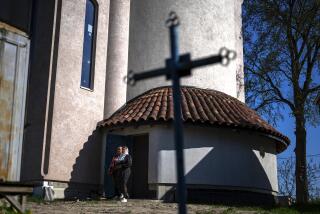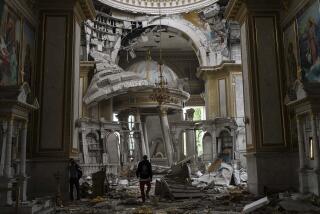Dubrovnik Can’t Quell Anger Over ’91 Attacks : Balkans: The Croatian port struggles to recover from Serbian barrages against an architectural jewel its residents--and the world--treasure.
DUBROVNIK, Croatia — A medieval fortress rises above the entrance to this ancient, now strangely pockmarked city of towers and ramparts. This is a place of graceful villas and Baroque palaces with the charred embers of their underbellies exposed to the morning light, a testimony to the fragility of stone and the resilience of fear.
More than 19 months after the Serbian attack that rained smoke, flame and devastation on a city too beautiful to be besieged by centuries of invaders, the anger and the memory refuse to settle into quiet.
An artist spends his days drawing endless pictures of Christ pulling the cross (“Why hast thou forsaken me?” they all say) and carefully labels pieces of shells that rocketed through his house. He displays them in cases in his living room, a museum of destruction open to the summer air through the charred rafters of his roof.
An old woman, one of 900 who crowded for protection into the old fortress during the first bombardment, still lives there nearly two years later. Her family has gone home. But she ventures out to join them for only half an hour a day, returning to the perceived safety of the fortress to sleep.
“My husband is very sad to see me so scared, but I had three times a direct hit on the roof of my house, and my husband and daughter are living there,” she said. “The radio said when you hear twice the alarm and then you hear the church bells ringing, this means the war is over. I’m waiting for this, even if I have to die.”
The end of Croatia’s war has not yet sounded in ancient Dubrovnik. It is an architectural treasure whose attack--after it was left unharmed over the centuries by Italian, French, Turkish and even Nazi German overlords--came to symbolize for Croatia its impotence against a Serbian war machine that was ready to turn its guns on the lovely city it sought to possess.
Now, as Croatian authorities debate a new cease-fire to end the uneasy state of no-war, no-peace with Serbian forces that still stand 12 miles northeast of the city, Dubrovnik remains largely isolated from the rest of Croatia and the world.
In ways, the war in Dubrovnik is not over because the city is not yet ready to forget.
“I refuse to accept the wisdom of experience, which teaches us that time heals all wounds,” Croatian author Bozidar Violic wrote recently. “I don’t want my wound to heal. Only an open wound can justify injured beauty, can bring back balance to disturbed harmony. Without our grief, it is lost forever.”
In the clear morning light that shows the scars of exploded shells against the city’s weathered white stone, Vesna Gamuilin, Dubrovnik’s petite former protocol director, pointed at the boarded-up facade of the Church of St. Blaise, the city’s patron. She made a face.
“Every small hit, every shell, offended us outrageously,” she said. “For us now, we have to make a balance between the beauty of the city and what has happened to it. Attraction and repulsion. We must always make the balance.”
Dubrovnik, on the Adriatic Sea, was founded before the 7th Century and grew into an independent commercial and naval power whose ships sailed around the world until it became part of Austria in 1815, and, finally, in 1918, part of the Yugoslavia created by the Treaty of Versailles.
Its Gothic, Renaissance and Baroque palaces, churches, convents and halls had remained breathtakingly preserved from the city’s golden age in the 15th and 16th centuries, and earlier, until Serbian and Montenegrin forces launched their first assault in October, 1991. They followed with a punishing, 12-hour barrage in early December during which more than 2,000 mortar rounds, artillery shells and rockets pounded the old city.
A survey by UNESCO, the U.N. cultural agency, found that 563 buildings--68% of the structures in the old walled city--were hit, including 314 direct shots on building facades and surfaces of the old cobbled streets and squares. Nine buildings were gutted by fire.
Except for gaping holes in roofs, widespread shelling marks and open rafters of burned buildings, the damage to Dubrovnik is not overwhelming to the eye, certainly not compared with the havoc wreaked upon old stone villages like Cilipi, Cavtat and Konavle.
Those villages are outside the walls of Dubrovnik, are rich in history and were left in ruins when their Serbian and Montenegrin occupiers pulled out in October of last year. Except for small pockets of structures left standing, almost every home in those areas was destroyed by Serbian forces that moved in, looted what they could and torched what remained with flame-throwers.
The occupation pushed 18,000 refugees into hotels in the tiny area around Dubrovnik not overtaken by the Serbs and left those who remained behind at the mercy of the invasion force. Old women tell stories of soldiers who burst into their homes and hauled away their china and television sets, then burned what was left.
In Cilipi, residents report that brutal military officials ordered regular beatings of the few local folk who remained in their homes until the commanders were replaced by a new captain who halted the practice.
Ivo Skuric recalls, however, how the captain broke into an abandoned house next door and found a piano left behind by two young music students. The Serbian officer began playing and the music winnowed around the village. “He was sitting in that empty house, and he was playing the piano. It was the war, so it was hard for me to make it out,” Skuric, 57, says, his face rapt has he tries to remember. “It was a very pleasant melody.”
The next day, the captain showed up with a truck at the door and hauled the piano away.
The toll of such nightmarish happenings is predictable. Dubrovnik Medical Center’s psychology unit has seen a fivefold increase in patients in the past year. A survey of refugees found that 82% were bordering on clinical psychological disorders.
At the Lero Cafe a little more than a year ago, a 23-year-old soldier quietly finished his drink, left the cafe and returned moments later with a hand grenade, tossing it into the crowded bar.
The streets of Dubrovnik are full of soldiers, idling against ancient stone walls, some sporting Rambo-like headbands along with their combat fatigues, many hauling a Doberman pinscher or pit bull terrier close at their side.
“I think this is the black hole of the Earth right now,” says Dr. Lubica Maric, head of the psychology unit in Dubrovnik. She pulled out a postcard from a 49-year-old man who had fled nearly two years ago with the first bombardment. In it, he noted the shelling attack as recently as June on three villages near Dubrovnik. “God help us all,” he wrote. “I’m not coming back.”
“What rational advice can I give him?” Maric said. “I look around and try to rationalize what is happening, and it’s not possible.”
Yet more than ever there are signs of a readiness to put the war aside and rebuild.
In the ruined village of Cilipi, where the church was the only building left standing, Mass is said each Sunday morning and dozens of former residents drive in to attend.
Just across from the church square, Luko Novak has returned with his wife and four children to live in what remains of his house, a single room intact with no substantial roof. He hopes to benefit from the loans of 70,000 German marks the government will begin offering soon to those whose houses were destroyed.
Every day, his sons help haul out the rubble to prepare for reconstruction. Novak, however, fears he won’t be able to begin before winter, when rains will force him and his family back into a refugee hotel.
“But I want to be an optimist,” he says. “If this evil wins, then the whole world is finished. Such an evil thing cannot prevail.”
In Dubrovnik’s old city, the sidewalk cafes were crowded on a recent sunny afternoon. But most of the customers were local residents, who, with factories destroyed, had nothing else to do. Eight tourists were registered at the local information bureau. A survey tallied 50 foreign tourists last week, compared with the 5.5 million overnight tourist visits registered before the war in 1990.
Without a revitalization of tourism, Dubrovnik will not revive. But as with much of Croatia’s Dalmatian Coast, cut off because of Serbian occupation from all land links to the capital except a single aging bridge, that isn’t likely until the war is finally, and officially, over.
Just up the coast, cities like Sibenik and Zadar still undergo regular shelling by Serbian militias. And while Dubrovnik hasn’t seen any shelling since June, neither tourists nor investors seem ready to gamble.
A few retail shops are open, but only one of the city’s fabled shipping companies has resumed operations. Hotels are full not of tourists, but refugees.
Much of the Dalmatian Coast dwells in a twilight zone. Electricity is available only a few hours a day in most of the coastal communities. Dubrovnik got full power restored a month ago but may go back on rationing again soon, and residents were doing their laundry and bathing in the sea until recently.
“You cannot say Dubrovnik lives very much. Dubrovnik exists. Basically, the whole Dalmatian Coast is an island, and we are at the end of it,” said Capt. Miso Mihocevic, liaison officer in Dubrovnik for the Croatian army.
Before the war, he was producer of Dubrovnik’s famed Summer Festival. On a recent evening, he sat in camouflage fatigues on the terrace of the Argentina Hotel, rolling his own cigarettes. As a piano began softly tinkling inside, he broke into a quiet rendition of “As Time Goes By.”
“Going from the arts to the army under normal circumstances, I think, is inconceivable. But when your country, your house, your family is attacked, I think it’s the only normal transformation. Because you have to defend what’s vital,” he said, recounting the first days when he watched helplessly as the old city came under attack by local Serbian and Montenegrin militias and the federal Yugoslav army and navy.
“It was inconceivable that an army would start destroying its own cities,” he said.
A sliver of moon began rising over the smooth Adriatic, and Mihocevic fell silent for a moment. “When this is over, what I need and will need every day the more is good holidays, good long holidays, far away from here,” he said.
Before the war, musicians and theater companies from around the world performed at the Dubrovnik festival, held for 43 years until its cancellation last year.
The inter-university center, representing 240 universities from 50 countries, held seminars for students all over the world in its Austro-Hungarian era building near the gates to the old city before it was destroyed.
“We will not ask here in Dubrovnik for money for rebuilding. We will rebuild somehow, if it takes 1,000 years. But what we want is the scientific and cultural interchange we once had,” said Ivana Burdjelez, who is helping to foster the city’s cultural rebirth. “The other things will take care of themselves, millimeter by millimeter.”
Murphy, The Times’ Cairo Bureau chief, was recently on assignment in the Balkans.
More to Read
Sign up for Essential California
The most important California stories and recommendations in your inbox every morning.
You may occasionally receive promotional content from the Los Angeles Times.










